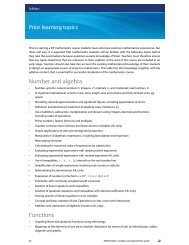DCIS Newsletter June 2018
Content: DCIS Proms 2018 Letter from the Principal: June Highlights Primary School June Highlights from Ms Lebihan Secondary School June Highlights from Mrs. Hyland 2018 Swimming Galas Global Campus Competition Winners Upper Primary Sports Assembly Global Campus Expedition: Les Martinets Advice and Guidance: Transitions Secondary House Science Quiz 2EN and 2HG Celebrate Hari Raya Puasa
Content:
DCIS Proms 2018
Letter from the Principal: June Highlights
Primary School June Highlights from Ms Lebihan
Secondary School June Highlights from Mrs. Hyland
2018 Swimming Galas
Global Campus Competition Winners
Upper Primary Sports Assembly
Global Campus Expedition: Les Martinets
Advice and Guidance: Transitions
Secondary House Science Quiz
2EN and 2HG Celebrate Hari Raya Puasa
You also want an ePaper? Increase the reach of your titles
YUMPU automatically turns print PDFs into web optimized ePapers that Google loves.
Advice and Guidance:<br />
Transitions<br />
The end of a school year can be an exciting but<br />
challenging time for many children and families.<br />
Uncertainties about new classes and teachers,<br />
even new schools and countries, can all add<br />
to the worry that some children (and their<br />
parents!) may feel. It is natural to feel some<br />
excitement and even worry when anticipating<br />
such a significant change. We can help to reduce<br />
this worry for our families by being prepared for<br />
the change.<br />
Here are 7 tips taken from an article<br />
on Psychology Today, with input from<br />
Psychologist Doug Ota, which you may find<br />
helpful:<br />
1. Say your goodbyes<br />
“Moving, at its psychological core, is an<br />
experience of loss,” writes Ota. Saying<br />
goodbye to the people, places, and the roles<br />
that are left behind is an inherently difficult<br />
but necessary step. By helping children say<br />
a clear goodbye, we are helping them to say<br />
a clear hello.<br />
2. Pick pivotal people<br />
Pick a few important people from your<br />
child’s life from back “home” (grandparents,<br />
neighbours, friends) with whom your child<br />
could check in once in a while and tell them<br />
about their new life. It’s important to choose<br />
people who are staying put. This way, they<br />
can become the pivots around which your<br />
child’s stories can rotate.<br />
3. Listen<br />
“Do not underestimate the healing power<br />
of simply attending to whatever a child<br />
is saying,” writes Ota. Listen reflectively –<br />
discerning the core message, or reading<br />
between the lines – then repeat the core<br />
message back to the child to make sure you<br />
got them correctly. This shows empathy and<br />
the intention of wanting to truly understand<br />
their feelings and experiences. “Having you<br />
as an audience is often all they need.”<br />
4. Maintain traditions<br />
From an evolutionary perspective, human<br />
beings resist change. When everything in the<br />
landscape starts changing, we intuitively<br />
tighten our grasp on things that have<br />
stayed the same. For a successful mobility<br />
experience, Ota suggests maintaining<br />
continuity in space and time. This entails<br />
not only bringing along familiar things such<br />
8<br />
as furniture, pictures and sacred objects, but<br />
also traditions. Whether they are Sunday<br />
dinners or bedtime rituals, doing the same<br />
things you used to do at the same time in<br />
your new place will provide this continuity.<br />
5. Give children choices<br />
During a move, children often feel like they<br />
don’t have any choice or control over various<br />
parameters of their lives. “The long-term<br />
absence of control over these parameters<br />
can lead to two alternatives, either angry<br />
rebellion or learned helplessness,” writes<br />
Ota. The solution could be to give children<br />
choices. Whether it’s big ones (e.g., which<br />
school to attend) or small ones (e.g., how<br />
to decorate their rooms), having them<br />
participate in decision-making will help<br />
them feel like not everything is out of<br />
their control and thus, help to boost their<br />
confidence.<br />
6. Welcome difficult feelings<br />
Often children will get the sense that they<br />
are not allowed to have negative feelings<br />
about the move. “Many feel under pressure<br />
from their parents (“Why can’t you just be<br />
positive for a change?”) or their environment<br />
(“You’re so lucky to be going to live abroad!”)<br />
to bury negative feelings,” according to<br />
Ota. These feelings have a better chance of<br />
relaxing and not popping up later in life if<br />
they are validated rather than when they are<br />
oppressed or denied. Encourage your child<br />
to feel like they are allowed to have all kinds<br />
of emotions about the move – including the<br />
negative ones. After all, navigating through<br />
life’s ups and downs is a skill well worth<br />
acquiring.<br />
7. Extra help for the introverts<br />
A lot of factors come into play with how<br />
well and how quickly we adapt to new<br />
environments. One of them is personality.<br />
“The more extroverted and assertive a<br />
person is, and the more he or she is open<br />
to new experiences, the more quickly he<br />
or she will adapt through the challenges<br />
of mobility,” says Ota. What about the<br />
introverts? Children who are shy or<br />
cautious, may inherently need more time<br />
to process their feelings and adapt to<br />
new environments. You can help these<br />
children by making them understand their<br />
personality strengths and the circumstances<br />
under which they thrive. “Teach them to<br />
look for somebody else who’s probably<br />
feeling afraid, like somebody standing by<br />
themselves,” suggests Ota. “Teach them<br />
to take a big deep breath, walk up to that<br />
person, and introduce themselves. Then<br />
find out where the person’s coming from,<br />
and what his or her hobbies are. Before they<br />
know it, they might have a friend.”<br />
Alison Ford<br />
Counsellor<br />
References<br />
Ota, D. (2014). Safe Passage, How mobility affects<br />
people and what international schools should do<br />
about it. Summertime Publishing, UK.<br />
Pogosyan, M. (2016). Helping Children Through<br />
Transitions. Psychology Today.<br />
https://www.psychologytoday.com/us/blog/<br />
between-cultures/201609/helping-childrenthrough-transitions


















